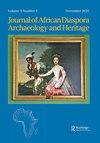Pasts Lost: The Wye House Plantation as a Place of Haunting
Q1 Arts and Humanities
Journal of African Diaspora Archaeology and Heritage
Pub Date : 2020-11-15
DOI:10.1080/21619441.2020.1840835
引用次数: 0
Abstract
ABSTRACT Much of what we know about the Wye House Plantation in Talbot County, Maryland in the nineteenth century comes from the writings of Frederick Douglass, who was enslaved there. His descriptions of the landscape serve as a starting point for thinking about the past experiences of the enslaved people within this place. The terror and violence that the landscape represented in slavery conjures up not only the events of the past, but also the ways that trauma echoes throughout generations. Using Douglass’ autobiographies, archaeology, landscape studies, the works of Toni Morrison, and ideas about the hauntings of place, there are ways to think about this plantation as a landscape of irreparable loss, but also of return and resolution.迷失的过去:怀伊庄园作为一个闹鬼的地方
我们对19世纪马里兰州塔尔博特县怀伊庄园的了解,大部分来自弗雷德里克·道格拉斯(Frederick Douglass)的著作,他当时是那里的奴隶。他对风景的描述是思考这个地方被奴役者过去经历的起点。奴隶制所代表的恐怖和暴力不仅让人想起过去的事件,也让人想起创伤在几代人身上回响的方式。利用道格拉斯的自传、考古学、景观研究、托妮·莫里森的作品,以及关于这个地方的鬼魂的想法,我们有办法把这个种植园看作是一个不可挽回的损失,但也是一个回归和解决的景观。
本文章由计算机程序翻译,如有差异,请以英文原文为准。
求助全文
约1分钟内获得全文
求助全文
来源期刊

Journal of African Diaspora Archaeology and Heritage
Arts and Humanities-History
CiteScore
0.80
自引率
0.00%
发文量
9
期刊介绍:
Journal of African Diaspora Archaeology and Heritage provides a focal point for peer-reviewed publications in interdisciplinary studies in archaeology, history, material culture, and heritage dynamics concerning African descendant populations and cultures across the globe. The Journal invites articles on broad topics, including the historical processes of culture, economics, gender, power, and racialization operating within and upon African descendant communities. We seek to engage scholarly, professional, and community perspectives on the social dynamics and historical legacies of African descendant cultures and communities worldwide. The Journal publishes research articles and essays that review developments in these interdisciplinary fields.
 求助内容:
求助内容: 应助结果提醒方式:
应助结果提醒方式:


